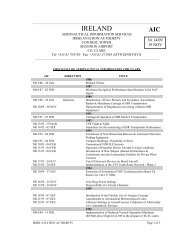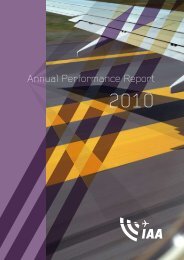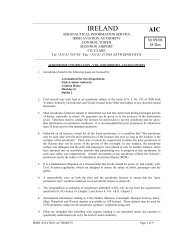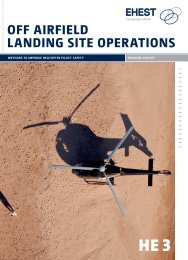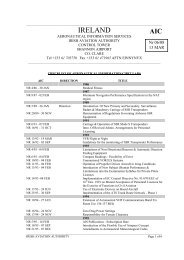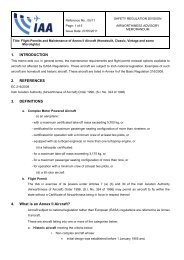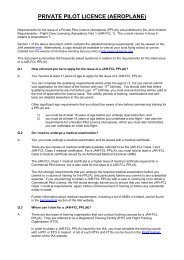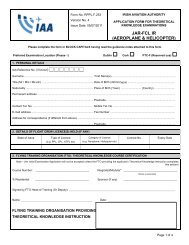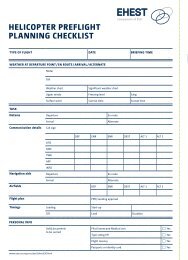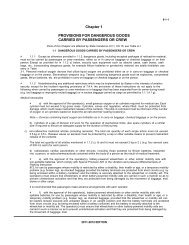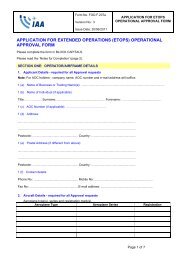ENR 2.2 OTHER REGULATED AIRSPACE - Irish Aviation Authority
ENR 2.2 OTHER REGULATED AIRSPACE - Irish Aviation Authority
ENR 2.2 OTHER REGULATED AIRSPACE - Irish Aviation Authority
Create successful ePaper yourself
Turn your PDF publications into a flip-book with our unique Google optimized e-Paper software.
05 FEB 2015<br />
AIP IRELAND<br />
<strong>ENR</strong> <strong>2.2</strong> - 1<br />
05 FEB 2015<br />
<strong>ENR</strong> <strong>2.2</strong><br />
<strong>OTHER</strong> <strong>REGULATED</strong> <strong>AIRSPACE</strong><br />
SPECIAL PROCEDURES WITHIN THE SHANNON UTA/SOTA/NOTA FOR NORTH ATLANTIC TRAFFIC<br />
1. INTRODUCTION<br />
A significant proportion of NAT traffic transits the Shannon UTA/SOTA/NOTA to and from major European<br />
destination areas. The following paragraphs describe the procedures for NAT traffic transiting this Airspace.<br />
2. ATS ROUTEING PROCEDURES FOR WESTBOUND NAT TRAFFIC<br />
In the Westbound NAT OTS signal Shanwick OAC promulgates the track structure(s) applicable together with such<br />
other information as may be considered useful for operators to identify the route to be flown.<br />
3. ATS ROUTEING PROCEDURES FOR EASTBOUND NAT TRAFFIC<br />
3.1 The domestic Landfall points KESIX, OSBOX, BEGID, SOVED, MOGLO, NETKI, KOKIB, BEXET, OLGON, GISTI,<br />
RILED, XETBO, LEKVA, ELSOX, EPUNA, ATSUR, BIMGO, NERTU, GUNSO and EMPER, which are associated<br />
with the Oceanic Entry points, are promulgated in the eastbound OTS message. Use of these points may vary from<br />
day to day depending on the published OTS.<br />
3.1.1 If an Eastbound NAT Flight operating to a specified destination is rerouted via an oceanic Landfall different to that<br />
filed in the flight plan, the flight may route DCT from the new Landfall to the original filed exit point from <strong>Irish</strong> Airspace.<br />
In the event of an alternative route being issued by IFPS Shannon ATC will advise the flight on first contact.<br />
4. IDENTIFICATION OF NAT TRACK MESSAGES & CLEARANCE DELIVERY PROCEDURES<br />
4.1 Track Message Identification (TMI)<br />
See UK IAIP<br />
4.2 Oceanic Clearance Procedures for Transit Westbound Aircraft<br />
4.2.1 Westbound aircraft operating within the Shannon FIR/UIR/SOTA/NOTA should request Oceanic Clearance from<br />
Shanwick Oceanic on the appropriate frequency or via ORCA Datalink.<br />
4.<strong>2.2</strong> Aircraft unable to contact “Shanwick Oceanic” on VHF or via ORCA Datalink should request clearance on a NARTEL<br />
HF frequency and thereafter maintain a SELCAL watch for receipt of the Oceanic Clearance.<br />
4.2.3 Aircraft unable to contact “Shanwick Oceanic” on VHF, via ORCA Datalink or on NARTEL HF should request<br />
Shannon Area Control Centre to relay their request for Oceanic Clearance to Shanwick.<br />
4.2.4 Aircraft in communication with Shanwick for Oceanic Clearance, on VHF or HF are to maintain communication with<br />
Shannon Control on the appropriate frequency<br />
4.3 Request for clearance should include:-<br />
• Flight Identification<br />
• Flight Identification<br />
• Oceanic Entry point and ETA<br />
• Requested MACH No and Flight Level<br />
• Any change to flight plan affecting OCA<br />
4.3.1 Oceanic clearance must be received prior to entering Oceanic Airspace.<br />
4.4 Oceanic Clearance Request for aircraft departing from <strong>Irish</strong> Aerodromes<br />
4.4.1 NAT flights departing <strong>Irish</strong> aerodromes, excluding Dublin Aerodrome, Weston Aerodrome and Casement<br />
(Baldonnel) Aerodrome, planned to enter NAT Airspace between GOMUP and BEDRA (inclusive) should request<br />
Oceanic Clearance from Shanwick Oceanic via ORCA Datalink prior to departure. Shannon ACC will on request<br />
obtain Oceanic Clearance from Shanwick Oceanic and pass the clearance to the flight prior to departure. Flights<br />
departing <strong>Irish</strong> airports planned to enter NAT Airspace north of GOMUP, or at OMOKO or LASNO, shall obtain<br />
Clearance when airborne and in accordance with provisions of <strong>ENR</strong> <strong>2.2</strong> 4.2 here above.<br />
4.4.2 Shannon<br />
Operating companies or their agents should contact Shannon Area Control Centre<br />
Phone: + 353 61 770 700 EXTN 122/123<br />
45 minutes before ETD or pilots of aircraft should contact Shannon Area Control Centre on frequency 121.7MHz 45<br />
minutes before ETD, to request Oceanic Clearance. Pilots should contact Shannon ATCC on frequency 121.7MHz<br />
at least 15 minutes before start up, to obtain Oceanic clearance.<br />
4.4.3 Dublin Aerodrome, Weston Aerodrome and Casement (Baldonnel) Aerodrome:<br />
<strong>Irish</strong> <strong>Aviation</strong> <strong>Authority</strong><br />
AIRAC Amdt 001/15
05 FEB 2015<br />
<strong>ENR</strong> <strong>2.2</strong> - 2<br />
05 FEB 2015<br />
AIP IRELAND<br />
Aircraft departing Dublin Aerodrome, Weston Aerodrome and Casement (Baldonnel) Aerodrome planned to enter<br />
NAT Airspace should request Oceanic Clearance when airborne. Pilots should make this request via ORCA Datalink<br />
or Shanwick Radio 127.9 MHz.<br />
4.4.4 Other Aerodromes<br />
The operating company or its agent should contact the ATS Unit at the airport of departure 45 minutes before ETD<br />
and request Oceanic Clearance.<br />
4.5 Oceanic Clearance Delivery for Shannon/Cork Departures on NAT OTS<br />
4.5.1 Oceanic Clearance for Shannon/Cork Departures on NAT OTS shall be issued by Shanwick using the track letter<br />
without the current NAT Track message identification number.<br />
Example of ATC issued clearance “Shanwick clears N865J to KJFK FL350 Track Bravo Mach.82 to cross LIMRI at<br />
1245 + or - 2 minutes”.<br />
4.5.2 Pilots shall include the NAT Track message identification numbers in the read back of the Oceanic Clearance.<br />
Example of pilot read back: “N865J is cleared to KJFK via Track BRAVO, maintain Flight Level Three Five Zero,<br />
Mach decimal Eight Two to cross LIMRI at 1245 + or – 2 minutes”. The Track ID is 256.<br />
4.5.3 If the Track message identification number is included in the read back there is no requirement for the pilot to read<br />
back the NAT Track co-ordinates.<br />
4.5.4 If any doubt exists as to the Track message identification of the NAT Track co-ordinates the pilot should request the<br />
full Track co-ordinates from the relaying ATS unit.<br />
4.5.5 Similarly, if the pilot fails to identify the correct Track ID or fails to respond with the Track ID, the ATS unit shall<br />
request a full read back of the clearance with the NAT track co-ordinates.<br />
4.6 Oceanic Clearance Delivery for other Aerodromes on NAT OTS<br />
For Oceanic Clearance on NAT OTS Departures from the other Aerodromes, the ATS unit shall issue the Oceanic<br />
Clearance to the flight on behalf of Shanwick Oceanic and read the cleared NAT Track coordinates in full and<br />
request a full read back of those co-ordinates.<br />
4.7 Oceanic Clearance Delivery for Random Routeings<br />
For aircraft cleared on random routeings from any airport, the present procedure of reading the full track co-ordinates<br />
as part of the Oceanic clearance and requesting a full read back from the pilot is unchanged.<br />
5. OCEANIC FLIGHT PLANS<br />
5.1 Flight plans in respect of Oceanic flights which are planned to enter Shannon FIR/UIR/SOTA/NOTA must be<br />
submitted to IFPS.<br />
5.2 Jet aircraft intending to operate in the Shanwick OCA must indicate the MACH number planned to be used for any<br />
portion of the flight within the area in Item 15 of the ICAO flight plan.<br />
Jet aircraft should indicate their proposed speeds in the following sequence:<br />
a. Cruising speed (TAS) in knots;<br />
b. Oceanic Entry point and cruising MACH number;<br />
c. Landfall Fix and cruising speed (TAS) in knots.<br />
5.3 All other aircraft: speed in terms of TAS in knots.<br />
6. SELCAL OPERATION IN THE NAT REGION<br />
During the time that they depend on HF communications, pilots should maintain a listening watch on the assigned<br />
frequency. This will not be necessary, however, if SELCAL is fitted and used correctly.<br />
Correct SELCAL use includes:-<br />
i. The provision of the SELCAL code in the flight plan;<br />
ii. The issue of a correction to the SELCAL code if subsequently altered due to change of aircraft or equipment;<br />
and<br />
iii. A check on the operation of the SELCAL equipment at or prior to initial entry into oceanic airspace with the<br />
appropriate radio station. This SELCAL check must be completed prior to commencing SELCAL watch.<br />
SELCAL watch on the assigned HF frequency should be maintained, even in areas of the Region where VHF<br />
coverage is available and used for air/ground communications.<br />
AIRAC Amdt 001/15<br />
<strong>Irish</strong> <strong>Aviation</strong> <strong>Authority</strong>
05 FEB 2015<br />
AIP IRELAND<br />
<strong>ENR</strong> <strong>2.2</strong> - 3<br />
05 FEB 2015<br />
7. RADIO COMMUNICATIONS FAILURE PROCEDURES FOR OCEANIC AIRCRAFT INTENDING TO<br />
ENTER OR EXIT NAT <strong>AIRSPACE</strong> VIA SHANNON FIR/UIR/SOTA/NOTA<br />
7.1 The following procedures apply to oceanic aircraft intending to enter or exit NAT airspace via the Shannon FIR/UIR/<br />
SOTA/NOTA. These procedures are intended to complement and not supersede State procedures/regulations. It is<br />
not possible to provide guidance for all situations associated with a communications failure.<br />
7.2 General<br />
7.2.1 The pilot of an aircraft experiencing a two-way radio communications failure shall operate the secondary radar<br />
transponder on identity Mode A Code 7600 and Mode C.<br />
7.<strong>2.2</strong> The pilot shall also attempt to contact any ATC facility (on VHF or HF) or another aircraft and inform them of the<br />
difficulty and request they relay information to the ATC facility with whom communications are intended.<br />
7.3 Communications Failure Prior To Entering NAT Oceanic Airspace<br />
Due to the potential length of time in oceanic airspace, it is strongly recommended that a pilot experiencing<br />
communications failure whilst still in Shannon FIR/UIR/SOTA/NOTA does not enter Shanwick Oceanic Control Area<br />
but adopts the procedure specified at Procedure A below. However, if the pilot elects to continue then, to facilitate<br />
the provision of adequate separation, adopt either the Procedure B or Procedure C below.<br />
Procedure A<br />
For this procedure the pilot is deemed to have selected Shannon as the aerodrome of intended landing. Proceed,<br />
maintaining the last assigned and acknowledged flight level, to the appropriate hold specified for Shannon and hold<br />
for a period of not less than five minutes. Then commence descent and complete a normal instrument approach.<br />
For the procedure as outlined in this paragraph and in order to avoid ambiguity Shannon is the only <strong>Irish</strong> aerodrome<br />
which may be used.<br />
Procedure B<br />
If operating with a received and acknowledged oceanic clearance, the pilot shall enter oceanic airspace at the<br />
cleared first oceanic entry point, level and speed and proceed in accordance with the received and acknowledged<br />
oceanic clearance. Any level or speed changes required to comply with the oceanic clearance shall be completed<br />
within Shannon FIR/UIR/SOTA/NOTA in the vicinity of the oceanic entry point.<br />
Procedure C<br />
If operating without a received and acknowledged oceanic clearance, the pilot shall enter oceanic airspace at the<br />
first oceanic entry point, level and speed, as contained in the filed flight plan and proceed via filed flight plan route<br />
to landfall. Maintain the first filed oceanic level and speed to landfall. Any level or speed changes required shall be<br />
completed within Shannon FIR/UIR/SOTA/NOTA in the vicinity of the oceanic entry point.<br />
7.4 Communications Failure Prior To Exiting NAT Oceanic Airspace<br />
7.4.1 Cleared on Flight Plan Route<br />
The pilot shall proceed in accordance with the last received and acknowledged oceanic clearance to the last<br />
specified oceanic route point, normally landfall and maintain the last assigned oceanic level and speed to this point.<br />
Unless the pilot elects to adopt the procedure outlined at <strong>ENR</strong> <strong>2.2</strong> 7.4.3 below, after landfall proceed in accordance<br />
with the filed flight plan (Level/speed/route).<br />
7.4.2 Cleared on other than Flight Plan Route the pilot shall proceed in accordance with the last received and<br />
acknowledged oceanic clearance to the last specified oceanic route point, normally landfall. Unless the pilot elects<br />
to adopt the procedure outlined at <strong>ENR</strong> <strong>2.2</strong> 7.4.3 below, after passing this point, proceed to the next significant point<br />
ahead of the track of the aircraft as contained in the filed flight plan. Maintain the last assigned oceanic level and<br />
speed to landfall, thereafter the flight level and speed contained in the filed flight plan.<br />
7.4.3 Diversion to Shannon<br />
In the event of the pilot electing to divert to Shannon, after landfall proceed direct to the appropriate hold specified<br />
for Shannon in Table 1: here under, maintaining the last assigned oceanic level and hold for a period of not less than<br />
five minutes. Then commence descent and complete a normal instrument approach. For the procedure as outlined<br />
<strong>Irish</strong> <strong>Aviation</strong> <strong>Authority</strong><br />
AIRAC Amdt 001/15
05 FEB 2015<br />
<strong>ENR</strong> <strong>2.2</strong> - 4<br />
05 FEB 2015<br />
AIP IRELAND<br />
in this paragraph and in order to avoid ambiguity Shannon is the only <strong>Irish</strong> aerodrome which may be used.<br />
Table 1: Appropriate Holds specified for Shannon<br />
HOLD<br />
RWY<br />
DERAG for ILS approach 24<br />
ELPOM for ILS approach 06<br />
8. REQUEST FOR OCEANIC RE-CLEARANCE FOR AIRCRAFT TRANSITING THE SHANNON FIR/<br />
UIR/NOTA AND SOTA.<br />
Aircraft requesting a change to their Ocean clearance must,<br />
a. If East of 10W make their request to Shanwick on VHF/HF or CPDLC<br />
otherwise<br />
b. If West of 10W make their request to Shannon ACC on VHF.<br />
9. STRATEGIC LATERAL OFFSET PROCEDURE<br />
The Strategic Lateral Offset Procedure (SLOP) is now a standard operating procedure throughout the North Atlantic<br />
(NAT) Region. This procedure mitigates collision risk and wake turbulence encounters. Pilots conducting oceanic<br />
flight within the NAT Region with automatic offset programming capability are recommended to fly lateral offsets of<br />
either 1 or 2 NM right of centre line.<br />
The introduction of very accurate aircraft navigation systems, along with sophisticated flight management systems,<br />
has drastically reduced the number of risk bearing lateral navigation errors reported in NAT airspace. Paradoxically,<br />
the capability of aircraft to navigate to such a high level of accuracy has led to a situation where aircraft on the same<br />
track but at different levels, are increasingly likely to be in lateral overlap. This results in an increased risk of collision<br />
if an aircraft departs from its cleared level for any reason.<br />
SLOP reduces risk by distributing aircraft laterally. It is applicable within the New York Oceanic, Gander Oceanic,<br />
Shanwick Oceanic, Santa Maria Oceanic, Sondrestrøm and Reykjavik flight information regions, and within the<br />
Bodo Oceanic flight information region when flights are operated more than 185km (100 NM) seaward from the<br />
shoreline.<br />
SLOP conforms to direction in the International Civil <strong>Aviation</strong> Organization’s (ICAO) Procedures for Air Navigation<br />
Services–Air Traffic Management (PANS–ATM, Doc 4444, 15.2.4) and is subject to the following guidelines:<br />
• Aircraft without automatic offset programming capability must fly the route centre line.<br />
• Operators capable of programming automatic offsets may fly the centre line or offset one or two nautical<br />
miles right of centre line, allowing for 3 possible positions along route. Offsets are not to exceed 2 NM right<br />
of centre line and offsets to the left of centre line are not permitted. An aircraft overtaking another aircraft<br />
should offset within the confines of this procedure, if capable, so as to create the least amount of wake<br />
turbulence for the aircraft being overtaken. The pilot should take into account wind and estimated wake<br />
vortex drift and time to descend. (Nominal descent rates for wakes are 300-600 FPM).<br />
• Pilots should use whatever means is available (e.g. TCAS, communications, visual acquisition) to determine<br />
the best flight path to fly. Pilots may contact other aircraft on frequency 123.45MHz, as necessary, to<br />
coordinate the best wake turbulence offset option.<br />
• Pilots may apply an offset outbound after the oceanic entry point and must return to centre line before the<br />
oceanic exit point. Position reports transmitted via voice should be based on the waypoints of the current ATC<br />
clearance and not the offset positions.<br />
• Aircraft transiting oceanic radar areas may remain on their established offset positions.<br />
• There is no ATC clearance required for this procedure and it is not necessary that ATC be advised.<br />
10. SHANNON OCEANIC TRANSITION AREA (SOTA)<br />
10.1 The Shannon Oceanic Transition Area (SOTA)<br />
AIRAC Amdt 001/15<br />
<strong>Irish</strong> <strong>Aviation</strong> <strong>Authority</strong>
05 FEB 2015<br />
AIP IRELAND<br />
<strong>ENR</strong> <strong>2.2</strong> - 5<br />
05 FEB 2015<br />
consists of that portion of the Shanwick Flight Information Region/Oceanic Control Area with lateral and vertical<br />
limits specified at Table 2:<br />
Name, Lateral limits,<br />
Vertical limits, Class of Airspace<br />
Table 2: Shannon Oceanic Transition Area<br />
Unit providing<br />
service<br />
Call Sign. Languages. Area<br />
and conditions of use.<br />
Hours of Service<br />
Frequency /<br />
Purpose<br />
Remarks<br />
1 2 3 4 5<br />
Shannon Oceanic Transition Area (SOTA) ATS Shannon Shannon Control 135.600MHz<br />
5100N 01500W, 5100N 00800W, 4830N<br />
English<br />
00800W, 4900N 01500W, 5100N 01500W<br />
H24<br />
FL055/FL660 - Class A<br />
FL660/UNL - Class G<br />
10.2 Addressing of Flight Plan Messages<br />
Flight plans required for the SOTA should be addressed to the IFPS addresses EUCHZMFP and EUCBZMFP.<br />
10.3 Delegation of Control within Airspace Contiguous with SOTA<br />
10.3.1 Control of GAT above FL245 within the airspace bounded by lines joining the coordinates listed below is delegated<br />
by the UK authorities to Shannon UAC.<br />
4935.00N 00800.00W: 4933.38N 00656.04W: 4855.70N 00734.46W: 4850.00N 00800.00W: 4935.00N 00800.00W<br />
10.3.2 Control of GAT above FL245 within the airspace bounded by lines joining the coordinates listed below is delegated<br />
by the French authorities to Shannon UAC.<br />
4850.00N 00800.00W: 4855.70N 00734.46W: 4830.00N 00800.00W: 4850.00N 00800.00W.<br />
10.3.3 Procedures applicable within the airspace described at <strong>ENR</strong> <strong>2.2</strong> 10.3.1 and <strong>ENR</strong> <strong>2.2</strong> 10.3.2 above are those<br />
procedures applicable within SOTA. The following applies:<br />
• Controlling <strong>Authority</strong> - Shannon UAC<br />
• Call sign - Shannon Control<br />
• Frequency - As allocated by ATS<br />
10.4 Position Reports<br />
All designated points on the SOTA boundary are compulsory position reporting points, unless otherwise advised by<br />
Shannon ACC.<br />
10.5 Oceanic Clearance Procedures<br />
Requirements regarding requests for oceanic clearances, detailed above, <strong>ENR</strong> <strong>2.2</strong> 4.2 and or <strong>ENR</strong><strong>2.2</strong> 8 should be<br />
complied with.<br />
10.6 Met Reporting Procedures in SOTA<br />
10.6.1 Pilots of aircraft in the SOTA are required to comply with the MET reporting procedures in ICAO DOC 7030.<br />
10.6.2 Westbound North Atlantic (NAT) Random flights and NAT Oceanic Track System (OTS) flights, designated as MET<br />
reporting flights, are to treat W008 as a mid-point and W015 as a designated Reporting point. Pilots are to transmit<br />
their W015 and W008 MET reports with their W015 position Report to Shanwick on HF<br />
10.6.3 Eastbound flights are not required to make routine MET reports when flying in the SOTA.<br />
10.7 Secondary Surveillance Radar<br />
Aircraft intending to fly in the SOTA must be equipped with an SSR transponder capable of responding to Mode A<br />
interrogations with 4096 codes and Mode C interrogations with Automatic Pressure Altitude Reporting.<br />
10.8 Communications<br />
Communications between aircraft in the SOTA and Shannon ACC are via VHF. The appropriate frequencies are<br />
listed in <strong>ENR</strong> 2.1 unless otherwise advised by Shanwick, Scottish or Shannon ACC. Flights unable to contact<br />
Shannon ACC on VHF should use the appropriate HF facility, addressing their message to Shannon ACC.<br />
10.9 Communications Failure<br />
Flights experiencing radio communications failure should proceed according to the procedures in <strong>ENR</strong> 1.1 General<br />
Rules, where appropriate, by procedures described in <strong>ENR</strong><strong>2.2</strong> 7<br />
10.10 Minimum Navigation Performance Specifications (MNPS)<br />
<strong>Irish</strong> <strong>Aviation</strong> <strong>Authority</strong><br />
AIRAC Amdt 001/15
05 FEB 2015<br />
<strong>ENR</strong> <strong>2.2</strong> - 6<br />
05 FEB 2015<br />
AIP IRELAND<br />
The MNPS shall be applicable in that volume of airspace between FL285 and FL420 within the Oceanic Control<br />
Areas of Santa Maria, Shanwick, Reykjavik, Gander Oceanic and New York Oceanic. SOTA airspace is not included<br />
in MNPS Airspace.Details of MNPS Operations and Procedures are contained in MNPS Operations Manual, and<br />
Regional Supplementary Procedures (DOC 7030).<br />
11. NORTHERN OCEANIC TRANSITION AREA (NOTA)<br />
11.1 The Northern Oceanic Transition Area (NOTA) consists of that portion of the Shanwick<br />
consists of that portion of the Shanwick Flight Information Region/Oceanic Control Area with lateral and vertical<br />
limits specified at Table 3:<br />
Name, Lateral limits,<br />
Vertical limits, Class of Airspace<br />
Table 3: Northern Oceanic Transition Area<br />
Unit providing<br />
service<br />
Call Sign. Languages. Area<br />
and conditions of use.<br />
Hours of Service<br />
Frequency /<br />
Purpose<br />
Remarks<br />
1 2 3 4 5<br />
Northern Oceanic Transition Area (NOTA) ATS Shannon Shannon Control 122.980MHz<br />
5700N 01500W, 5700N 01000W, 5434N<br />
English<br />
01000W, 5400N 01500W, 5700N 01500W<br />
H24<br />
FL055/FL660 - Class A<br />
FL660/UNL - Class G<br />
11.2 Addressing of Flight Plan Messages<br />
Flight plans required for the NOTA should be addressed to the IFPS addresses EUCHZMFP and EUCBZMFP.<br />
11.3 Position Reports<br />
All designated points on the NOTA boundary are compulsory position reporting points, unless otherwise advised by<br />
Shannon ACC.<br />
11.4 Oceanic Clearance Procedures<br />
Requirements regarding requests for oceanic clearances, detailed above, <strong>ENR</strong> <strong>2.2</strong> 4.2 and or <strong>ENR</strong><strong>2.2</strong> 8 should be<br />
complied with.<br />
11.5 Met Reporting Procedures in NOTA<br />
11.5.1 Pilots of aircraft in the NOTA are required to comply with the MET reporting procedures in ICAO DOC 7030.<br />
11.5.2 Westbound North Atlantic (NAT) Random flights and NAT Oceanic Track System (OTS) flights, designated as MET<br />
reporting flights, are to treat W010 as a mid-point and W015 as a designated Reporting point. Pilots are to transmit<br />
their W015 and W010 MET reports with their W015 position Report to Shanwick on HF<br />
11.5.3 Eastbound flights are not required to make routine MET reports when flying in the NOTA.<br />
11.6 Secondary Surveillance Radar<br />
Aircraft intending to fly in the NOTA must be equipped with an SSR transponder capable of responding to Mode A<br />
interrogations with 4096 codes and Mode C interrogations with Automatic Pressure Altitude Reporting.<br />
11.7 Communications<br />
Communications between aircraft in the NOTA and Shannon ACC are via VHF. The appropriate frequencies are<br />
listed in <strong>ENR</strong> 2.1 unless otherwise advised by Shanwick, Scottish or Shannon ACC. Flights unable to contact<br />
Shannon ACC on VHF should use the appropriate HF facility, addressing their message to Shannon ACC.<br />
11.8 Communications Failure<br />
Flights experiencing radio communications failure should proceed according to the procedures in <strong>ENR</strong> 1.1 General<br />
Rules, where appropriate, by procedures described in <strong>ENR</strong><strong>2.2</strong> 7<br />
11.9 Minimum Navigation Performance Specifications (MNPS)<br />
The MNPS shall be applicable in that volume of airspace between FL 285 and FL420 within the Oceanic Control<br />
Areas of Santa Maria, Shanwick, Reykjavik Oceanic and New York Oceanic. NOTA airspace is included in MNPS<br />
Airspace. Details of MNPS Operations and Procedures are contained in MNPS Operations Manual, and Regional<br />
Supplementary Procedures (DOC 7030).<br />
AIRAC Amdt 001/15<br />
<strong>Irish</strong> <strong>Aviation</strong> <strong>Authority</strong>




